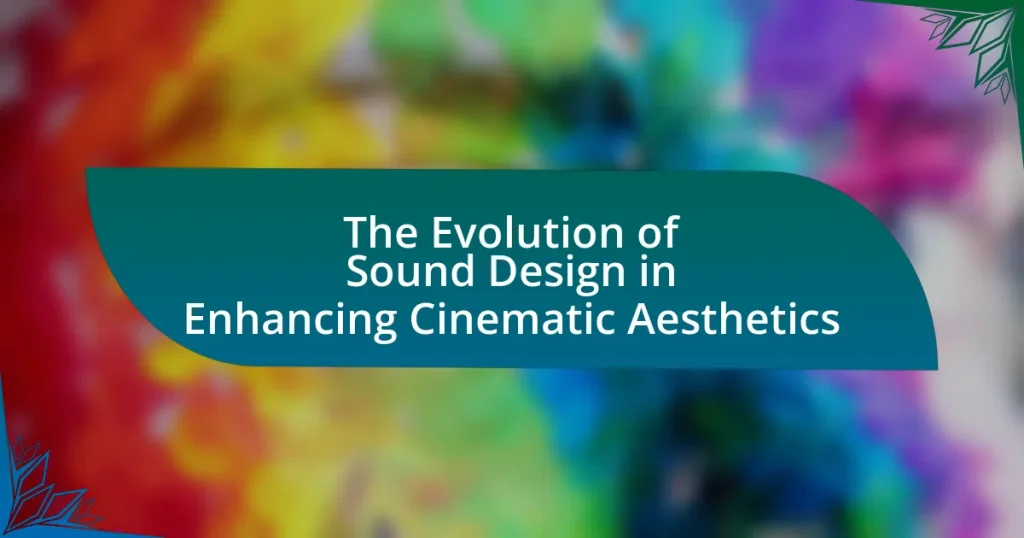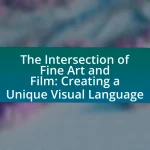The article examines the evolution of sound design and its critical role in enhancing cinematic aesthetics. It traces the historical milestones from silent films to the introduction of synchronized sound in the late 1920s, highlighting advancements such as stereo sound and digital techniques that have transformed the auditory experience. Key elements of sound design, including dialogue, sound effects, and music, are discussed in relation to their impact on emotional engagement and narrative depth. The article also addresses the challenges faced by sound designers today, the influence of technology, and best practices for effective sound design in modern filmmaking.

What is the Evolution of Sound Design in Enhancing Cinematic Aesthetics?
The evolution of sound design has significantly enhanced cinematic aesthetics by transforming how audiences experience films. Initially, silent films relied solely on visual storytelling, with live music providing minimal auditory context. The introduction of synchronized sound in the late 1920s, exemplified by “The Jazz Singer” in 1927, marked a pivotal shift, allowing dialogue and sound effects to deepen narrative engagement.
As technology advanced, the 1950s and 1960s saw the emergence of stereo sound, enriching the auditory landscape and enabling filmmakers to create immersive environments. The use of Dolby Surround Sound in the 1970s further revolutionized sound design, allowing for spatial audio that enhanced emotional resonance and realism.
In contemporary cinema, digital sound design techniques, such as Foley and sound layering, have become standard, allowing for intricate soundscapes that complement visual elements. Films like “Inception” (2010) showcase how sound design can manipulate perception and heighten tension, demonstrating its critical role in cinematic storytelling.
Overall, sound design has evolved from basic auditory accompaniment to a sophisticated tool that shapes audience perception and emotional response, fundamentally enhancing the cinematic experience.
How has sound design transformed the cinematic experience over time?
Sound design has significantly transformed the cinematic experience by enhancing emotional engagement and narrative depth. Historically, the introduction of synchronized sound in the late 1920s, exemplified by “The Jazz Singer” in 1927, marked a pivotal shift, allowing filmmakers to integrate dialogue, music, and sound effects seamlessly. This integration created a more immersive environment, enabling audiences to connect with characters and stories on a deeper level.
As technology advanced, innovations such as Dolby Surround Sound in the 1970s and digital sound mixing in the 1990s further enriched the auditory experience, allowing for spatial audio that mirrors real-life sound perception. These developments have led to a more dynamic and realistic soundscape, which enhances the storytelling by providing auditory cues that complement visual elements.
Moreover, the use of sound design techniques, such as Foley and sound layering, has become essential in crafting unique auditory identities for films, making sound an integral part of the cinematic language. This evolution underscores the critical role of sound design in shaping audience perceptions and emotional responses throughout the history of cinema.
What historical milestones mark the development of sound design in film?
The development of sound design in film is marked by several key historical milestones, including the introduction of synchronized sound in “The Jazz Singer” (1927), which was the first feature-length film with synchronized dialogue, revolutionizing the industry. The transition to fully recorded sound in the late 1920s and early 1930s established sound as a critical element of storytelling in cinema. The advent of stereo sound in the 1950s, exemplified by films like “West Side Story,” enhanced the auditory experience, allowing for a more immersive environment. The introduction of digital sound in the 1990s, particularly with “Jurassic Park” (1993), further transformed sound design by enabling complex soundscapes and effects. Each of these milestones significantly contributed to the evolution of sound design, shaping how audiences experience films.
How did technological advancements influence sound design practices?
Technological advancements significantly influenced sound design practices by introducing new tools and techniques that enhanced audio quality and creativity. The development of digital audio workstations (DAWs) in the late 20th century allowed sound designers to manipulate sound with unprecedented precision, enabling complex layering and effects that were not possible with analog equipment. Additionally, advancements in software plugins and virtual instruments expanded the sonic palette available to designers, facilitating innovative soundscapes in film and media. For instance, the introduction of Pro Tools in the 1990s revolutionized post-production workflows, allowing for real-time editing and mixing, which improved efficiency and creativity in sound design. These technological innovations have fundamentally transformed how sound is created, edited, and integrated into cinematic experiences.
Why is sound design crucial for cinematic storytelling?
Sound design is crucial for cinematic storytelling because it enhances emotional engagement and narrative depth. By utilizing sound effects, dialogue, and music, filmmakers create an immersive experience that guides audience perception and emotional response. For instance, studies show that sound can influence viewer interpretation of scenes, with specific audio cues triggering emotional reactions that visuals alone may not achieve. This interplay between sound and image is essential for conveying themes, building tension, and establishing atmosphere, ultimately enriching the storytelling experience.
What role does sound play in creating emotional responses in audiences?
Sound plays a crucial role in creating emotional responses in audiences by enhancing the narrative and evoking feelings through auditory cues. Research indicates that specific sound elements, such as music, sound effects, and silence, can significantly influence viewers’ emotional states. For instance, a study published in the Journal of Experimental Psychology found that music can alter emotional perception, with major keys often eliciting happiness and minor keys inducing sadness. Additionally, sound effects can heighten tension or create a sense of relief, directly impacting audience engagement and emotional investment in the story. This interplay between sound and emotion is essential in cinematic experiences, as it shapes how audiences connect with characters and narratives.
How does sound design contribute to world-building in films?
Sound design significantly contributes to world-building in films by creating immersive auditory environments that enhance the viewer’s experience of the narrative. Through the use of sound effects, ambient sounds, and musical scores, filmmakers establish the tone, mood, and authenticity of the film’s setting. For instance, in “Star Wars,” the iconic sounds of lightsabers and alien creatures help to construct a distinct universe that feels both foreign and believable. This auditory layering not only supports visual elements but also evokes emotional responses, making the fictional world more relatable and engaging for the audience.
What are the key elements of sound design in cinema?
The key elements of sound design in cinema include dialogue, sound effects, ambient sound, and music. Dialogue is crucial for conveying the narrative and character emotions, while sound effects enhance realism and impact, such as footsteps or explosions. Ambient sound creates a sense of space and atmosphere, grounding the viewer in the film’s environment. Music underscores emotional moments and can influence audience perception, as seen in scores by composers like John Williams. Each element works together to create an immersive experience, significantly affecting audience engagement and storytelling.
What types of sounds are utilized in film sound design?
Film sound design utilizes various types of sounds, including dialogue, sound effects, ambient sounds, and music. Dialogue is the spoken words of characters, crucial for storytelling. Sound effects are artificially created or enhanced sounds that add realism or emphasize actions, such as footsteps or explosions. Ambient sounds provide the background noise that establishes the setting, like birds chirping or city traffic. Music, whether diegetic or non-diegetic, enhances emotional impact and guides audience reactions. Each type of sound plays a vital role in creating an immersive cinematic experience, as evidenced by the significant impact of sound design in award-winning films like “Dunkirk,” where sound was integral to the storytelling.
How do sound effects, dialogue, and music interact in a film?
Sound effects, dialogue, and music interact in a film by creating a cohesive auditory experience that enhances storytelling and emotional engagement. Sound effects provide realism and context, dialogue conveys character and plot, while music sets the emotional tone and atmosphere. For instance, in “Star Wars,” the iconic sound effects of lightsabers and spaceships complement the dialogue between characters, while John Williams’ score elevates the emotional stakes, demonstrating how these elements work together to immerse the audience in the narrative. This synergy is essential for effective sound design, as it influences viewer perception and emotional response, ultimately shaping the cinematic experience.
How does sound design enhance specific cinematic genres?
Sound design enhances specific cinematic genres by creating an immersive auditory experience that complements the visual storytelling. In horror films, for example, sound design utilizes unsettling noises and silence to build tension and evoke fear, as seen in classics like “Psycho,” where the iconic shower scene’s score heightens the emotional impact. In contrast, action films employ dynamic sound effects and fast-paced music to amplify excitement and adrenaline, exemplified by the “Mad Max: Fury Road” score, which intensifies the film’s relentless pace. Additionally, in romantic films, sound design often incorporates soft melodies and ambient sounds to evoke intimacy and emotion, as demonstrated in “La La Land,” where the musical score enhances the romantic atmosphere. Thus, sound design is integral to shaping the audience’s emotional response and enhancing the overall experience within various cinematic genres.
What unique sound design techniques are used in horror films?
Unique sound design techniques used in horror films include the use of dissonant soundscapes, silence, and Foley effects. Dissonant soundscapes create an unsettling atmosphere by employing unconventional musical intervals and harsh sound textures, which heighten tension and evoke fear. Silence, strategically placed, amplifies suspense by creating a stark contrast to sudden loud sounds, making the audience more alert and anxious. Foley effects, which are custom sound effects created to enhance the realism of a scene, often include exaggerated sounds like creaking doors or footsteps, contributing to the immersive experience of horror. These techniques are supported by studies indicating that sound significantly influences emotional responses in viewers, making them essential tools in horror filmmaking.
How does sound design differ in action versus drama films?
Sound design in action films primarily focuses on creating an immersive and high-energy auditory experience, while drama films emphasize subtlety and emotional resonance. In action films, sound effects such as explosions, gunfire, and intense musical scores are used to heighten tension and excitement, often employing techniques like layering and dynamic range to amplify the impact of each sound. For instance, the use of Dolby Atmos technology in films like “Mad Max: Fury Road” enhances the spatial quality of sound, making the audience feel as if they are part of the action.
In contrast, drama films prioritize dialogue clarity and ambient sounds that support character development and emotional depth. The sound design in dramas often includes softer, more nuanced soundscapes that reflect the internal states of characters, as seen in films like “Moonlight,” where the sound design complements the narrative’s emotional arcs through subtle background sounds and music that evoke specific feelings. This difference in focus illustrates how sound design is tailored to serve the distinct narrative and emotional needs of each genre.
What challenges do sound designers face in modern cinema?
Sound designers in modern cinema face several challenges, including the integration of advanced technology, the need for high-quality sound in diverse formats, and the pressure to meet tight production schedules. The rapid evolution of sound technology, such as immersive audio formats like Dolby Atmos, requires sound designers to continuously update their skills and adapt to new tools. Additionally, the demand for high-fidelity sound across various platforms, including streaming services and theaters, complicates the design process, as sound must be optimized for different listening environments. Furthermore, the constraints of production timelines often limit the time available for sound design, making it difficult to achieve the desired artistic vision. These challenges highlight the complexities of sound design in a rapidly changing cinematic landscape.
How do budget constraints affect sound design quality?
Budget constraints significantly limit sound design quality by restricting access to high-quality equipment, skilled professionals, and extensive sound libraries. When budgets are tight, sound designers may resort to using lower-quality audio tools and less experienced personnel, which can lead to subpar audio production. For instance, a study by the University of Southern California found that films with higher sound budgets often received better critical acclaim and audience ratings, indicating a direct correlation between financial investment and sound quality. Additionally, limited budgets can restrict the time available for sound editing and mixing, further compromising the overall auditory experience in cinematic projects.
What are the common misconceptions about sound design in filmmaking?
Common misconceptions about sound design in filmmaking include the belief that sound is merely an afterthought, that it only serves to complement visuals, and that high-quality sound can be achieved without specialized skills or equipment. In reality, sound design is a critical component of storytelling that shapes audience perception and emotional response. For instance, studies show that sound can influence how viewers interpret scenes, with specific audio cues enhancing tension or evoking nostalgia. Additionally, professional sound design requires a deep understanding of acoustics, technology, and artistic intent, debunking the myth that anyone can produce effective sound without training or experience.
What future trends are emerging in sound design for cinema?
Future trends in sound design for cinema include the increased use of immersive audio technologies, such as Dolby Atmos and binaural sound, which create a three-dimensional sound experience. These technologies allow sound designers to place audio elements in a spatial context, enhancing the viewer’s emotional engagement and realism. Additionally, advancements in artificial intelligence are enabling more sophisticated sound editing and mixing processes, allowing for quicker iterations and more complex soundscapes. The integration of virtual reality (VR) and augmented reality (AR) in cinematic experiences is also driving the need for innovative sound design that complements visual storytelling. These trends reflect a shift towards creating more engaging and immersive cinematic experiences that resonate with audiences on multiple sensory levels.
How is virtual reality influencing sound design practices?
Virtual reality is significantly influencing sound design practices by enabling immersive audio experiences that enhance user engagement and emotional response. In VR environments, sound designers utilize spatial audio techniques to create a three-dimensional soundscape, allowing users to perceive sound directionality and distance, which is crucial for realism. Research indicates that immersive audio can increase the sense of presence in virtual environments, as demonstrated in studies like “The Role of Sound in Virtual Reality” by M. A. Slater and colleagues, which found that high-quality spatial audio improves user immersion and interaction. This evolution in sound design practices is reshaping how audio is integrated into cinematic experiences, making them more interactive and lifelike.
What role will artificial intelligence play in the future of sound design?
Artificial intelligence will significantly enhance sound design by automating processes, generating unique audio elements, and personalizing soundscapes. AI algorithms can analyze vast datasets of sound to create new audio textures and effects that were previously unattainable, allowing sound designers to explore innovative sonic possibilities. For instance, AI tools like OpenAI’s Jukedeck and AIVA have already demonstrated the capability to compose music and generate sound effects autonomously, showcasing the potential for AI to revolutionize the creative workflow in sound design. This integration of AI not only streamlines production but also enables sound designers to focus on artistic expression, ultimately enriching the cinematic experience.
What best practices can filmmakers adopt for effective sound design?
Filmmakers can adopt several best practices for effective sound design, including thorough pre-production planning, utilizing high-quality recording equipment, and integrating sound elements that enhance the narrative. Pre-production planning allows filmmakers to identify specific sound requirements and create a cohesive sound strategy. High-quality recording equipment ensures clarity and fidelity, which are crucial for immersive soundscapes. Additionally, integrating sound elements, such as ambient sounds, sound effects, and dialogue, in a way that complements the visuals can significantly enhance the emotional impact of a film. Research indicates that effective sound design can increase audience engagement and emotional response, as evidenced by studies showing that films with well-executed sound design often receive higher ratings from viewers.
How can collaboration between sound designers and directors improve outcomes?
Collaboration between sound designers and directors can significantly improve outcomes by ensuring that the audio elements align seamlessly with the director’s vision. This partnership allows for a more cohesive storytelling experience, as sound designers can tailor soundscapes that enhance the emotional and narrative aspects of a film. For instance, a study by the University of Southern California found that films with integrated sound design and direction received higher audience engagement scores, demonstrating that effective collaboration leads to a more immersive cinematic experience.
What tools and software are essential for modern sound design?
Essential tools and software for modern sound design include Digital Audio Workstations (DAWs) like Pro Tools, Ableton Live, and Logic Pro, as well as sound libraries such as Splice and Native Instruments. DAWs serve as the primary platforms for recording, editing, and mixing audio, enabling sound designers to manipulate sound effectively. For instance, Pro Tools is widely used in professional studios for its robust editing capabilities and industry-standard status. Sound libraries provide a vast array of pre-recorded sounds and samples, which are crucial for enhancing the auditory experience in film and media. The integration of these tools allows sound designers to create immersive soundscapes that significantly contribute to cinematic aesthetics.


